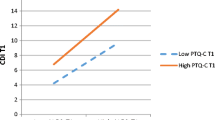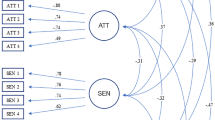Abstract
Temperament-based learning style preferences of 80 children, ages 8 to 17, 40 with conduct disorder (CD) and 40 with oppositional defiant disorder (ODD) were examined using the Student Styles Questionnaire (SSQ). The SSQ measures four dimensions of learning style preferences based on temperament theory (Extroverted-Introverted, Thinking-Feeling, Practical-Imaginative, and Organized-Flexible). Their T-scores were compared for strength of preference between the two disorders. In addition, analysis for frequency of preference among children with CD and ODD was compared to the frequency of preference typically found in the general population. When comparing the strength of temperament preferences of children with CD and ODD significant differences were noted only for Practical-Imaginative styles. Children with ODD displayed a stronger preference for acquiring and assessing new information in Practical styles than did children with CD. Students with CD or ODD did not differ significantly for strength of preference on Extroverted-Introverted, Thinking-Feeling, and Organized-Flexible styles. When comparing the frequency of temperament preferences of children with CD and ODD to preference rates found in the general population, significant differences were noted only for children with ODD. They more often indicated a preference for Practical and Thinking styles.
Similar content being viewed by others
References
American Psychiatric Association. (1994). Diagnostic and statistical manual of mental disorders (4th ed.). Washington, D.C.: Author.
American Psychiatric Association. (2000). Diagnostic and statistical manual of mental disorders (4th ed., rev.). Washington, D.C.: Author.
Atman, K. S. (1993). Goal accomplishment style and psychological type: Cultural variations. Psychological Type and Culture-East and West: Multicultural Research Symposium, 207–220.
Barkley, R. A. (1997). Defiant children: A clinician’s manual for parent training. New York: Guilford.
Barrett, L. (1989). Impact of teacher personality on classroom environment. Journal of Psychological Type, 18, 50–56.
Bates, J. E., Wachs, T. D., & Emde, R. N. (1994). Toward practical uses of biological concepts of temperament. In J. E. Bates & Y. D. Wachs (Eds.), Temperament: Individual differences at the interface of biology and behavior (pp. 275–306). Washington, D.C.: American Psychology Association.
Beyler, J., & Schmeck, R. R. (1992). Assessment of individual differences in preferences for holistic-analytic strategies: Evaluation of some commonly available instruments. Educational and Psychological Measurement, 52(3), 709–719.
Cornett, C. E. (1983). What you should know about teaching and learning styles. Bloomington, IN: Phi Delta Kappa Educational Foundation.
DiTiberio, J. K. (1977). The strength of sensing-intuition preference on the Myers-Briggs Type Indicator as related to empathic discrimination of overt or covert feeling messages of others. Dissertation Abstracts International, 37, 5599A. (UMI No. 77–5789).
Dodge, K. A., & Newman, J. P. (1981). Biased decision-making processes in aggressive boys. Journal of Abnormal Psychology, 90, 275–329.
Frick, P. J. (1998). Conduct disorders and severe antisocial behavior. New York: Plenum.
Galen. (1992). The art of cure-Extracts from Galen: Mailmoides’ medical writings. (U.S. Barzel, Trans.). Haifa, Israel: Maimonides Research Institute. (Original work published date unknown).
Harrison, D. F., & Lawrence, G. (1985). Psychological type and time orientation: Do middle school students differ in projecting their personal futures? Journal of Psychological Type, 9, 10–15.
Hippocrates. (1939). Hippocrates, 1. (W. H. S. Jones, Trans). Cambridge, MA: Harvard University Press. (Original work published date unknown).
Johnson, C., Zimmerman, A., & Brooker, N. (1994). Implications and applications of type theory on a two-year technical college campus. Proceedings: Orchestrating Educational Change in the 90’s — The Role of Psychological Type, 221–234.
Jung, C. G. (1971). Psychological types. (R. F. C. Hull, Revision of Trans. by H. G. Baynes). Princeton, NJ: Princeton University Press. (Original work published 1921).
Kagan, J., & Snidman, N. (1991). Infant predictors of inhibited and uninhibited profiles. Psychological Science, 2(1), 40–43.
Maslach, C., Jackson, S. E., & Leiter, M. P. (1996). Mashlach Burnout Inventory Manual (3rd ed.). Palo Alto, CA: Consulting Psychologists Press.
Myers, I. B. (1962). Manual: The Myers-Briggs Type Indicator. Princeton, NJ: Education Testing Service.
Myers, I. B., & McCaulley, M. (1985). Manual: A guide to the development and use of the Myers-Briggs Type Indicator (2nd ed.). Palo Alto, CA: Consulting Psychological Press.
Myers, I. B., McCaulley, M. H., Quenk, N. L., & Hammer, A. L. (1998). MBTI Manual: A guide to the development and use of the Myers-Briggs Type Indicator (3rd ed.). Palo Alto, CA: Consulting Psychologists Press.
Myers, I. B., & Myers, P. B. (1980). Gifts differing: Understanding personality type. Palo Alto, CA: Consulting Psychological Press.
Newman, J. (1985). Hemisphere specialization and Jungian typology-evidence for a relationship. Bulletin of Psychological Type, 10(2), 13–27.
Newman, L. E. (1979). Personality types of therapist and client and their use in counseling. Research in Psychological Type, 2, 46–55.
Oakland, T., Glutting, J. J., & Horton, C. B. (1996). Student Styles Questionnaire: Star qualities in learning, relating, and working. San Antonio, TX: The Psychological Corporation.
Oakland, T., Joyce, D., Glutting, J., & Horton, C. (2000). Temperament-based learning styles of male and female students identified as gifted and students not identified as gifted. Gifted Child Quarterly, 44(3), 183–189.
Patterson, G. R. (1982). Coercive family process. Eugene, OR: Castalia.
Rosenzweig, M. R., Leiman, A. L., & Breedlove, S. M. (1996). Biological psychology. Sunderland, MA: Sinauer.
Schurr, K. T., Ruble, V. E., Palomba, C., Pickerill, B., & Moore, D. (1997). Relationships between MBTI and selected aspects of Tinto’s model for college attrition. Journal of Psychological Type, 40, 31–42.
Shelton, J. (1996). Health, stress, and coping. In A. L. Hammer (Ed.), MBTI applications: A decade of research on the Myers-Briggs Type Indicator (pp. 197–215). Palo Alto, CA: Consulting Psychologists Press.
Stafford, M., & Oakland, T. (1996). Validity of temperament constructs using the Student Styles Questionnaire: Comparisons for three racial-ethnic groups. Journal of Psychoeducational Assessment, 14, 109–120.
Sternberg, G. (1990). Brain and personality: Extraversion/introversion in relation to EEG, evoked potentials and cerebral blood flow. Unpublished doctoral dissertation, University of Lund, Sweden.
Thomas, A., & Chess, S. (1989). Temperament and personality. In G. A. Kohnstamm, J. E. Bates, & M. K. Rothbart (Eds.), Temperament in childhood (pp. 249–261). New York: John Wiley.
Thorne, A. (1987). The press of personality: A study of conversations between Introverts and Extroverts. Journal of Personality and Social Psychology, 53(4), 718–726.
U.S. Department of Education. (2002). Twenty-fourth annual report to congress on the implementation of the individuals with disabilities education act. Jessup, MD: Author.
Vollbrecht, F. E. (1991). A study of selected personality characteristics of vocational trade and industrial education teachers. Dissertation Abstracts International, 52, 06–A.
Wilson, M. A., & Languis, M. L. (1990). A topographic study of difference in the P300 between introverts and extraverts. Brain Topography, 2(4), 369–274.
Author information
Authors and Affiliations
Corresponding author
Rights and permissions
About this article
Cite this article
Joyce, D., Oakland, T. Temperament Differences Among Children with Conduct Disorder and Oppositional Defiant Disorder. Contemp School Psychol 10, 125–136 (2005). https://doi.org/10.1007/BF03340927
Published:
Issue Date:
DOI: https://doi.org/10.1007/BF03340927




